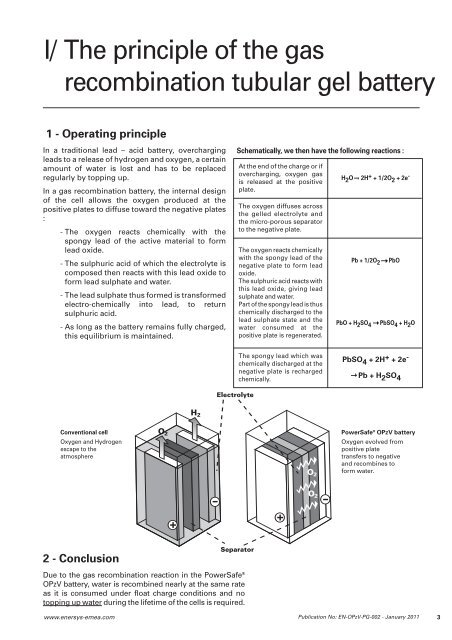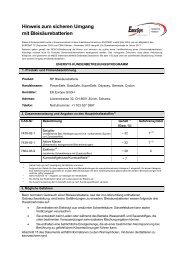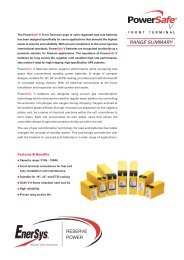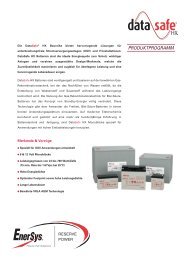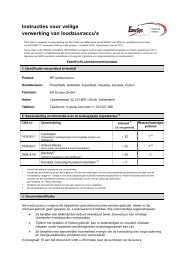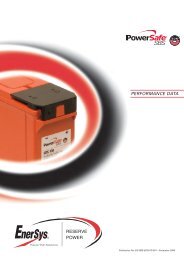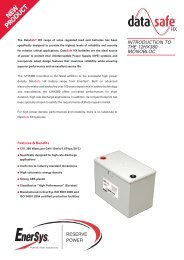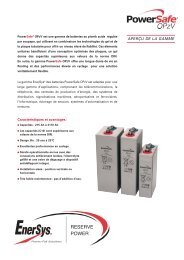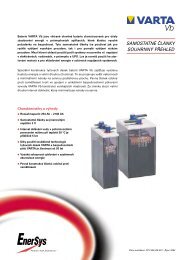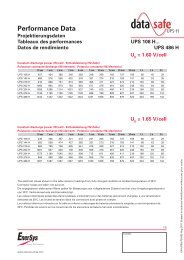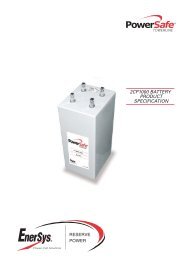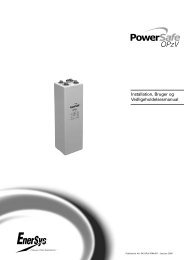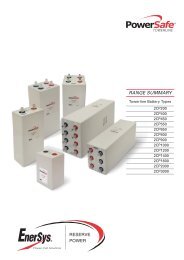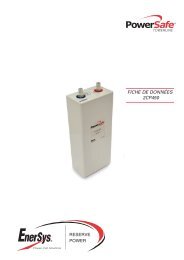En-Opzv-Pg-002 - Enersys - EMEA
En-Opzv-Pg-002 - Enersys - EMEA
En-Opzv-Pg-002 - Enersys - EMEA
You also want an ePaper? Increase the reach of your titles
YUMPU automatically turns print PDFs into web optimized ePapers that Google loves.
I/ The principle of the gas<br />
recombination tubular gel battery<br />
1 - Operating principle<br />
In a traditional lead – acid battery, overcharging<br />
leads to a release of hydrogen and oxygen, a certain<br />
amount of water is lost and has to be replaced<br />
regularly by topping up.<br />
In a gas recombination battery, the internal design<br />
of the cell allows the oxygen produced at the<br />
positive plates to diffuse toward the negative plates<br />
:<br />
- The oxygen reacts chemically with the<br />
spongy lead of the active material to form<br />
lead oxide.<br />
- The sulphuric acid of which the electrolyte is<br />
composed then reacts with this lead oxide to<br />
form lead sulphate and water.<br />
- The lead sulphate thus formed is transformed<br />
electro-chemically into lead, to return<br />
sulphuric acid.<br />
- As long as the battery remains fully charged,<br />
this equilibrium is maintained.<br />
Conventional cell<br />
Oxygen and Hydrogen<br />
escape to the<br />
atmosphere<br />
2 - Conclusion<br />
Due to the gas recombination reaction in the PowerSafe ®<br />
OPzV battery, water is recombined nearly at the same rate<br />
as it is consumed under float charge conditions and no<br />
topping up water during the lifetime of the cells is required.<br />
www.enersys-emea.com<br />
Schematically, we then have the following reactions :<br />
At the end of the charge or if<br />
overcharging, oxygen gas<br />
is released at the positive<br />
plate.<br />
The oxygen diffuses across<br />
the gelled electrolyte and<br />
the micro-porous separator<br />
to the negative plate.<br />
The oxygen reacts chemically<br />
with the spongy lead of the<br />
negative plate to form lead<br />
oxide.<br />
The sulphuric acid reacts with<br />
this lead oxide, giving lead<br />
sulphate and water.<br />
Part of the spongy lead is thus<br />
chemically discharged to the<br />
lead sulphate state and the<br />
water consumed at the<br />
positive plate is regenerated.<br />
The spongy lead which was<br />
chemically discharged at the<br />
negative plate is recharged<br />
chemically.<br />
H 2 O 2H + + 1/2O 2 + 2e -<br />
Pb + 1/2O 2<br />
PbO + H 2 SO 4<br />
PbO<br />
PbSO 4 + H 2 O<br />
PbSO 4 + 2H + + 2e -<br />
Pb + H 2 SO 4<br />
PowerSafe ® OPzV battery<br />
Oxygen evolved from<br />
positive plate<br />
transfers to negative<br />
and recombines to<br />
form water.<br />
Publication No: EN-OPzV-PG-<strong>002</strong> - January 2011<br />
3


